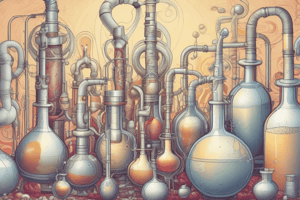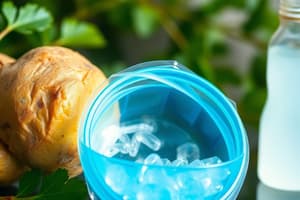Podcast
Questions and Answers
Which of the following statements about starch is TRUE?
Which of the following statements about starch is TRUE?
- Starch stores large amounts of glucose in a compact form. (correct)
- Starch is easily hydrolyzed when glucose is needed.
- Starch molecules are highly soluble in water, influencing osmotic pressure effectively.
- Starch is a large molecule that can diffuse through cell membranes.
Non-reducing sugars will turn Benedict's solution orange-red when heated.
Non-reducing sugars will turn Benedict's solution orange-red when heated.
False (B)
What color change indicates the presence of starch when iodine solution is added?
What color change indicates the presence of starch when iodine solution is added?
Brown/orange to blue-black
The Benedict's test can be used to identify _______ and _______ sugars.
The Benedict's test can be used to identify _______ and _______ sugars.
Match the following terms with their corresponding descriptions:
Match the following terms with their corresponding descriptions:
What are the three elements that make up carbohydrates?
What are the three elements that make up carbohydrates?
Disaccharides are formed by the combination of three monosaccharides.
Disaccharides are formed by the combination of three monosaccharides.
What is the primary function of carbohydrates in respiration?
What is the primary function of carbohydrates in respiration?
The process of breaking down a large molecule into smaller ones by adding water is called ______.
The process of breaking down a large molecule into smaller ones by adding water is called ______.
Match the following carbohydrates with their primary functions:
Match the following carbohydrates with their primary functions:
Which of the following is NOT a function of carbohydrates?
Which of the following is NOT a function of carbohydrates?
Glycogen is stored primarily in muscle cells.
Glycogen is stored primarily in muscle cells.
What is the main difference between starch and cellulose in terms of structure?
What is the main difference between starch and cellulose in terms of structure?
Flashcards
Insoluble substances
Insoluble substances
Do not change osmotic pressure when present in a solution.
Large molecules
Large molecules
Molecules that cannot diffuse through cell membranes due to their size.
Starch test
Starch test
Starch is detected by a color change from brown/orange to blue black with iodine.
Benedict's test
Benedict's test
Signup and view all the flashcards
Reducing vs Non-reducing sugars
Reducing vs Non-reducing sugars
Signup and view all the flashcards
Carbohydrates
Carbohydrates
Signup and view all the flashcards
Monosaccharides
Monosaccharides
Signup and view all the flashcards
Disaccharides
Disaccharides
Signup and view all the flashcards
Polysaccharides
Polysaccharides
Signup and view all the flashcards
Hydrolysis
Hydrolysis
Signup and view all the flashcards
Condensation
Condensation
Signup and view all the flashcards
Glycogen
Glycogen
Signup and view all the flashcards
Cellulose
Cellulose
Signup and view all the flashcards
Study Notes
Carbohydrates
- Composed of carbon, hydrogen, and oxygen
- One carbohydrate molecule has twice as many hydrogen atoms as carbon or oxygen atoms
- Sugars are the simplest type of carbohydrate
- Sugars are sweet and soluble in water
Functions of Carbohydrates
- Provide energy for cellular activities
- Contribute to structural components like plant cell walls
- Can be converted to other organic compounds like amino acids and fats
- Essential for nucleic acid formation (e.g., DNA)
Types of Carbohydrates
- Simple carbohydrates (monosaccharides and disaccharides)
- Monosaccharides are single sugar units (e.g., glucose, fructose, galactose)
- Disaccharides are formed by the combination of two monosaccharides (e.g., maltose, lactose, sucrose)
- Complex carbohydrates (polysaccharides)
- Polysaccharides are formed from many linked monosaccharides (e.g., starch, cellulose, glycogen)
- Starch is a storage carbohydrate in plants
- Glycogen is a storage carbohydrate in animals
- Cellulose is a structural carbohydrate in plants
Hydrolysis of Disaccharides
- Hydrolysis is the breaking of a chemical bond by the addition of water.
- Disaccharides are broken down into monosaccharides via hydrolysis.
- Maltose + water → glucose + glucose
- Sucrose + water → glucose + fructose
- Lactose + water → glucose + galactose
Condensation Reactions
- Condensation reactions link monosaccharides to create disaccharides and polysaccharides. This is the removal of water in the reaction.
- For example, glucose + glucose → maltose + water
Glycogen
- Glycogen is a storage form of glucose in animals.
- Glucose is transported to body cells and then the liver helps to regulate blood glucose levels through processes involving glycogen formation and breakdown.
- Glycogen is broken down into glucose when the body needs it
Starch
- Starch is a storage form of glucose in plants.
- Starch is stored in plant cells.
- When plants need glucose, starch breaks down into glucose.
- Starch is composed of many linked glucose molecules.
Cellulose
- Cellulose is a structural carbohydrate in plants.
- Cellulose is composed of long chains of glucose molecules.
- Unlike starch, the glucose molecules in cellulose are linked differently resulting in straight chains rather than spirals
Testing for Starch
- Iodine solution turns a dark blue-black color in the presence of starch.
Testing for Glucose
-
Benedict's solution is used to test for glucose. The solution changes color to indicate the concentration of glucose.
- If positive: blue solution changes color to various shades of orange/red.
Lipids
- Fats and oils are lipids
- Lipids consist of mostly carbon and hydrogen, with less oxygen than carbohydrates
- Fats are solid at room temperature, while oils are liquid at room temperature
- Each lipid molecule is a triglyceride, consisting of one glycerol molecule and three fatty acid molecules
- Lipids are insoluble in water, do not diffuse through cell membranes, easily hydrolyzed when needed, and are compact shapes allowing for storage in less space.
Functions of Fats
- Provide insulation and regulate body temperature
- Protect vital organs from mechanical damage
- Source of energy
- Stored for later energy use
- Essential components of cell membranes.
Studying That Suits You
Use AI to generate personalized quizzes and flashcards to suit your learning preferences.




